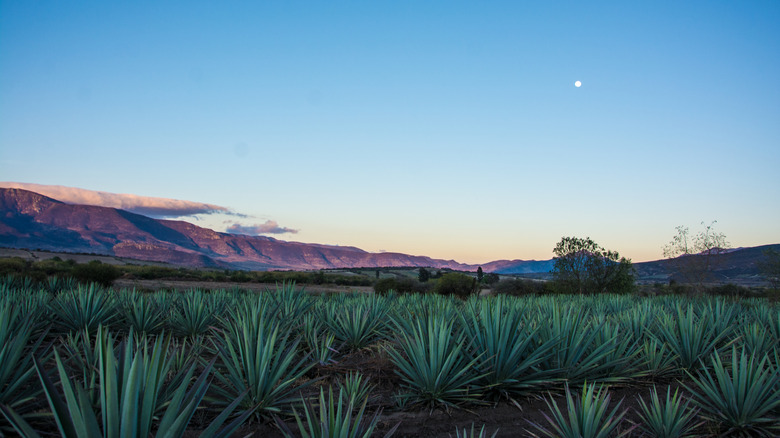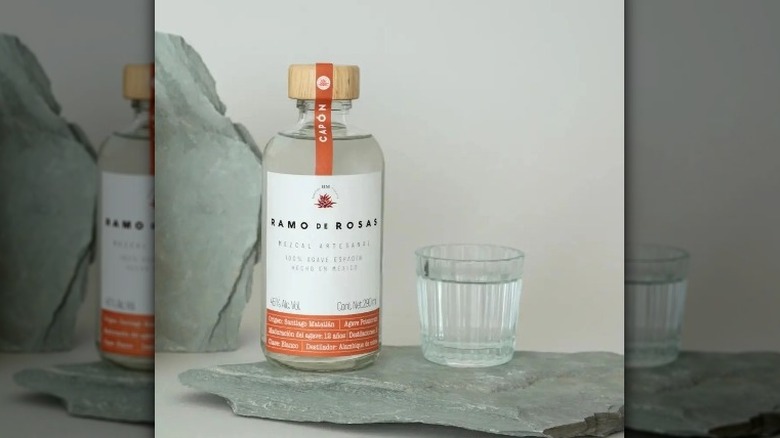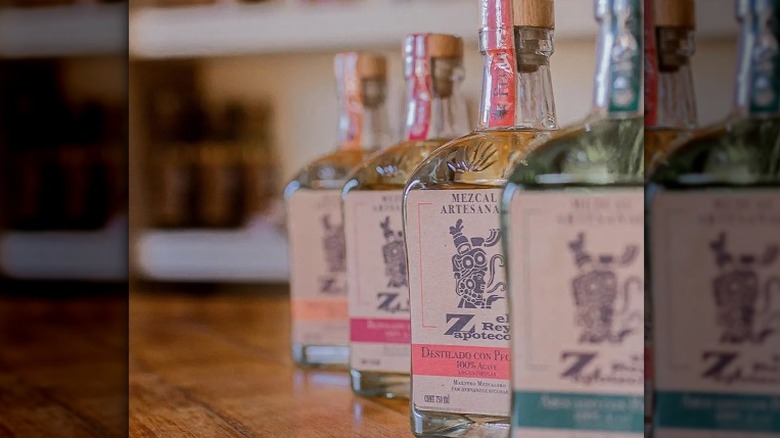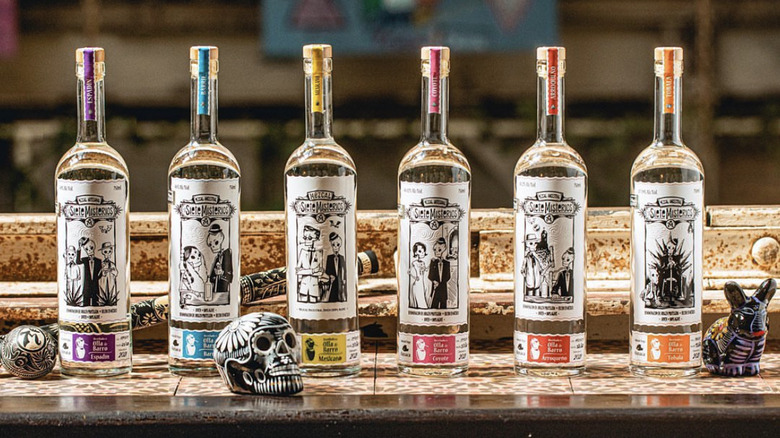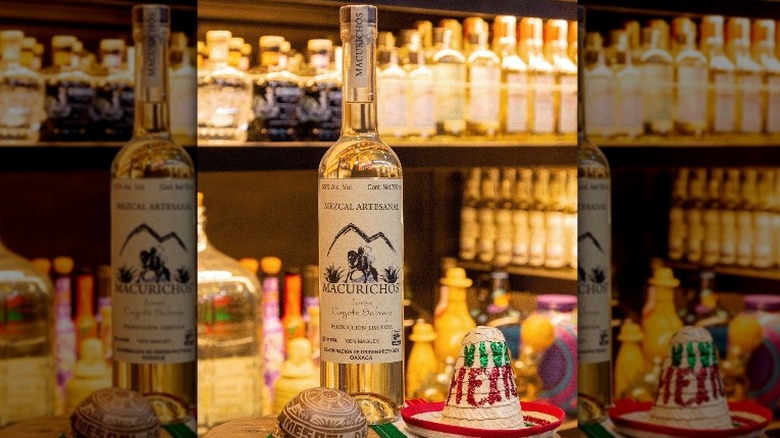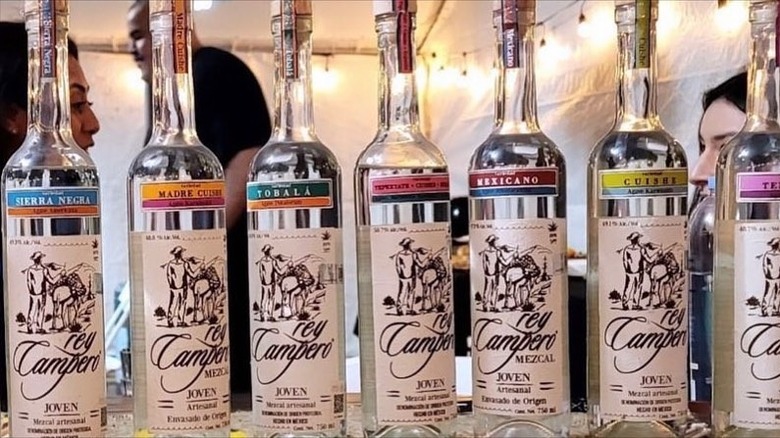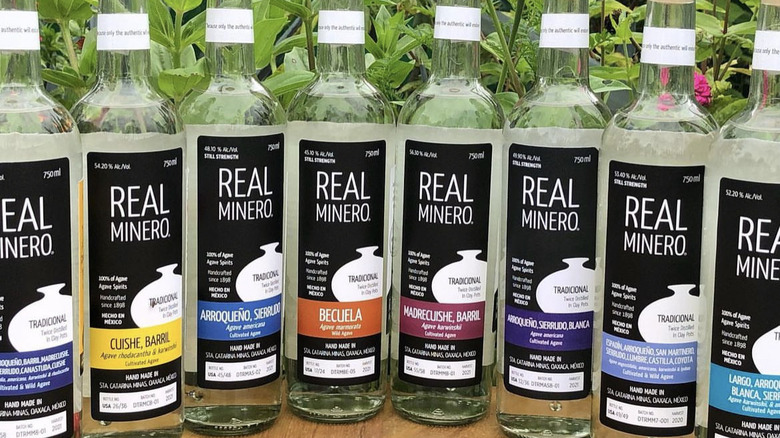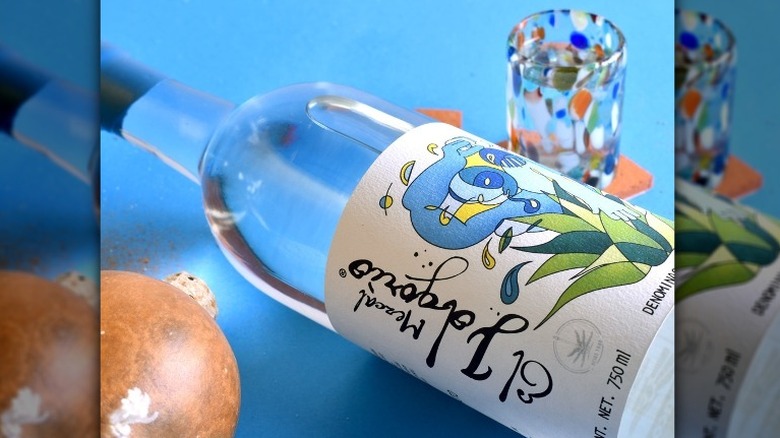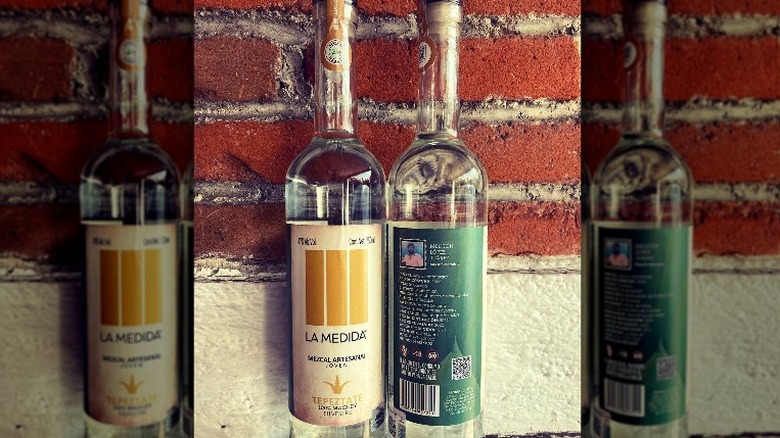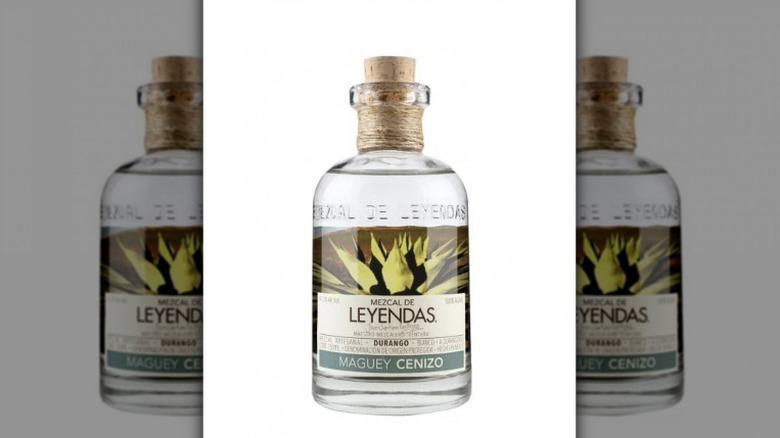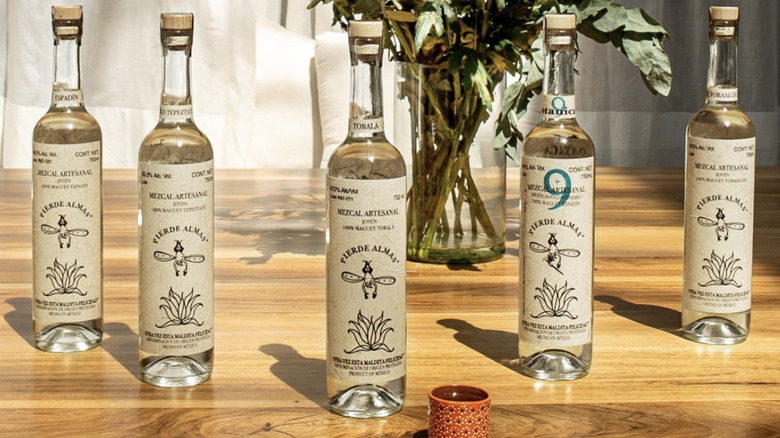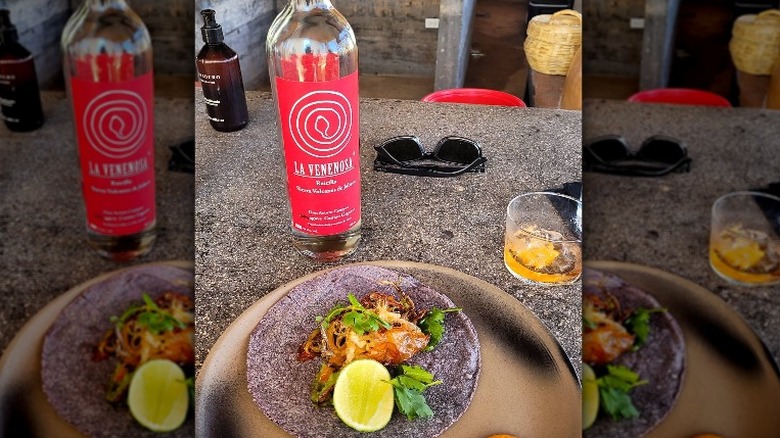11 Mezcal Varieties For Every Level Of Expertise
Deeply tied to Mexican history, culture, and mythology, mezcal is an agave-based spirit produced in 10 of the country's states, including Oaxaca, Guerrero, Zacatecas, and San Luis Potosí. Although it's closely related to tequila, there are a couple of key differences between the two spirits. Tequila can only be produced with agave tequilana weber (also known as blue agave), whereas mezcal can be made with any of the 166 agave species out there. The production process for both spirits starts with harvesting the agave (agave syrup can also sweeten your coffee), but when producing mezcal, the cores are cooked in an earthen pit, which gives mezcal its signature smoky notes. Afterward, both liquids are fermented, distilled, and bottled, but the time spent in the pit makes a major difference in the finished spirit.
Whether you are a mezcal first-timer or a longtime fan and explorer, there are countless agave varietals for you to explore, not to mention brands and labels. To guide you along this journey, we spoke to Ninotchka Daly, national brand ambassador for Ojo de Tigre mezcal, and Fanny Palma, head bartender at Mexico City's Baltra Bar. With their knowledge and taste, we've created a list that leaves no drinker unattended.
For first-timers: Ramo de Rosas Espadín
As the most widely-used agave in mezcal production, espadín is not only easy to find across mezcal brands, but it is also easy to drink and excellent as an entry-level varietal. Fanny, who loves using espadín in cocktails, recommends Ramo de Rosas Espadín, a mezcal born in Santiago Matatlán, Oaxaca. Mezcal master Margarito Hernández is in charge of the artisanal production, passing down the knowledge that his family has held for more than 70 years.
Hernández and his team use espadín capón agave that has matured for eight years. When they are cooking the agave cores (or piñas), they throw in a bunch of roses that will burn alongside the agave plants as an offering to the Virgin of the Rosary, patron of Santiago Matatlán. This offering is not only meant to ensure the Virgin's blessing for good production, but it also infuses the liquid with a touch of mysticism and faith. Later, the cooked agave is ground with a traditional horse-pulled tahona stone and fermented in wooden barrels. Finally, the mezcal passes through a double distillation in copper stills. The result is a bright, creamy mezcal with notes of dried fruit and a touch of smoke on the nose, and sweet, herbal notes of citrus on the palate.
For cocktail lovers: El Rey Zapoteco Tobalá
"Tobalá is one of the smoothest agaves, and also one of the most ancient ones," says Fanny. Tobalá takes between 12 and 15 years to mature and is a great agave varietal to use in cocktails, she explains, as it has a slightly sweet profile. Her favorite is El Rey Zapoteco Tobalá, one of the oldest brands in Oaxaca. El Rey Zapoteco is produced in Santiago Matatlán by the Hernández Escobar family, who have more than 60 years of experience.
Using artisanal production methods, the family harvests the agave using machetes and cooks the cores in cone-shaped stone ovens covered by fabric and soil. Afterward, they use a stone tahona to grind the cooked agave before fermenting it in pine and oak tubs. Finally, they distill the liquid twice in copper and coil stills, obtaining a shining, transparent liquid. On the nose, you will find smoky and slightly citrusy notes, which continue on the palate before you reach a silky, long finish.
Soft and smooth: Siete Misterios Arroqueño
Born in Oaxaca in 2010, Siete Misterios works with local producers who honor traditional methods, such as cooking the agave in underground ovens, grinding it in a traditional stone tahona, allowing it to ferment naturally, and distilling it at least twice in clay pots or copper stills, depending on what each producer's region and traditions dictate. The brand's small-batch production includes artisanal mezcals such as the balanced doba-yej and the complex blends or ensambles.
Siete Misterios Arroqueño, made in Sola de Vega by three mezcal masters, begins with a large, beautiful plant that can mature up to 25 years. In this case, the grinding is done by hand, and the distillation takes place in clay pots. "This mezcal has a very unique profile," says Fanny, "and can be herbal or boast some spicy notes." This arroqueño starts with soft, fruity notes on the nose, and continues with vegetal, tropical notes on the palate, plus baking spices and earthy notes that result in a long, smooth finish.
For collectors: Mezcal Macurichos
Drinkers who have been in the mezcal rodeo for a few years and have achieved collector status will be amazed by Macurichos, produced by mezcal master Gonzalo Martínez, a fierce defender of Oaxaca's mezcal traditions and agriculture. "This brand is hard to find nationwide, but I keep it for celebratory moments," says Nino.
At his palenque in Santiago Matatlán, Martínez and his family work with neighbors to produce mezcal using ancestral methods. Gonzalo and his brothers grow their own agave and make an effort to keep endangered wild agave growing. They rest their mezcal in glass containers and distill it in clay pots, resulting in small-batch, exquisite liquids such as Macurichos Madrecuishe, with aromas of thyme, jasmine, and cantaloupe, as well as lemon, pepper, and orange zest on the palate. Another rare item is Macurichos Conejo Pechuga, distilled in clay pots with rabbit, cinnamon, and several types of fruit. Its rich notes include cilantro, pink peppercorn, and roasted pineapple. "I like to pair Macurichos with fresh fruit and chocolate," says Nino, who praises the brand's "ultra-artisanal" methods.
For tradition lovers: Rey Campero
A family-based palenque, Casa Sánchez boasts four generations of mezcal-making experience. The Sánchez family's agave fields line the ground of Candelaria Yegolé, a tiny community on the foothills of Oaxaca's Sierra Sur. With their care for tradition and respect for the land, the Sánchez clan produces extraordinary mezcal for Rey Campero.
The family grows more than 10 types of agave, including espadín, jabalí, cuishe, and Mexicano. They cook the agave cores in a cone-shaped, stone-lined oven and cover it with river stones on which they place the agave, and then cover it with fabric and soil. Next, they grind the cooked agave with a stone tahona pulled by a horse or mule and ferment it in pine tubs. Distillation takes place twice in copper stills, which are heated with wood and then cooled with water from the river.
The resulting selection ranges from a classic espadín to an exotic Elixir Frutal (fruit elixir), infused with traditional holiday fruits like guava and prunes. "Their whole selection is fantastic," says Nino, who likes to sip these mezcals neat with a beer chaser on the side. "These mezcals are perfect for agave lovers who enjoy traditional products."
For premium mezcal aficionados: Real Minero Cuishe
Santa Catarina de Minas, in Oaxaca, is the birthplace of this mezcal, started by Don Francisco Ángeles. His offspring acquired the family's palenque in 1978 and have continued the tradition ever since. The Real Minero line includes labels like espadín, barril, and arroqueño, but it is their cuishe that Nino loves best. "I've been enjoying it a lot lately," she says. "I love it paired with natural soda or a pineapple tepache (a traditional Mexican fermented drink)." Interestingly, the brand no longer calls their product mezcal, but "agave spirit," as they have no relationship with the certification process since 2020. Their production process, however, has not changed much over the years.
The Real Minero Cuishe is produced with semi-wild, 12-year-old cuishe agave, which is cooked in a cone-shaped oven dug into the ground. The grinding takes place in an electric shredder, and afterward, the liquid is distilled twice in clay pots. Most Real Minero mezcal is rested in glass containers for months before reaching the bottle, which smooths and softens the spirit. Nino calls Real Minero a "niche brand" that is perfect for those serious about exploring premium mezcal.
For connoisseurs: El Jolgorio Jabalí
"This mezcal is a treat, as batches change over the years," says Nino about El Jolgorio jabalí, produced in various areas of Oaxaca. The heart behind El Jolgorio is the Cortés family, who have put together a collective made of 16 top-notch mezcal producers from 10 different regions in the state. Each family brings their own story, knowledge, and wisdom to the production, making each of El Jolgorio's small-batch mezcals unique.
The brand also produces limited editions using agave varietals that are endangered or limited, which you can identify because of their black bottles. The jabalí is one of these rare releases. Its story begins with wild jabalí plants that have matured up to 18 years and are distilled in copper stills. "It has a mix of leather and floral notes with an umami taste," says Nino, who recommends taking your time between sips of jabalí to appreciate the palate evolves, "much like a scotch or a glass of wine."
A taste of the land: La Medida Tepeztate
La Medida pays tribute to Oaxaca's strong mezcal tradition by maintaining a 100% artisanal production method, from the moment the seed is planted to the day when the liquid reaches the bottle. The selection includes the beloved espadín, as well as an array of wild agaves, such as arroqueño, tobalá, and americano.
This category also includes tepeztate, one of Fanny's favorites. Tepeztate takes between 15 and 30 years to reach maturity, and "has some of the strongest earthy notes out there," says Fanny. Its artisanal production process includes cooking in a cone-shaped stone oven, grinding in a tahona mill, fermenting in juniper tubs, and finally, distilling twice in copper pots. The final product is a clear-colored mezcal with aromas of black olives, asparagus, capers, and soil right after rainfall. On the palate, it's gentle and spicy, with vegetable and mineral notes.
Beyond Oaxaca: Mezcales de Leyenda Cenizo
Durango, one of the lesser-known producers, is the birthplace of this cenizo, which Nino loves for its "full body and strong, earthy notes." The master behind this liquid is José Ventura Gallegos, a second-generation producer who has been working his magic for more than two decades. His wild cenizo hails from the arid lands of Durango and is actually the most widely used agave for mezcal production in this state. The plant matures for 10 to 12 years and, once harvested, is cooked in an agave roasting pit.
Afterward, the cooked agave is milled with a mechanical grinder, fermented in ground-level wood vats, and finally, it is distilled in copper and wood stills. It has notes of wet clay, grassy fields, and leather on the nose, as well as coriander, stone fruit, and buttered popcorn on the palate. Nino likes pairing her cenizo with Topo Chico water so she can fully appreciate the intensity. "This mezcal is great for those who want to try something made outside Oaxaca," she says.
For gin drinkers: Pierde Almas +9 Botanicals
Mezcal, with its smokey, mystical personality, might not be appealing to some drinkers, especially those who believe it to be too strong or are loyal to other spirits. In cases like this, Nino recommends Pierde Almas +9 Botanicals, a sipping mezcal that might potentially captivate the hearts of gin lovers.
Espadín agave is the base of this unique spirit, made by mezcal master Gregorio Velasco Luis in San Luis del Río, Oaxaca. This spirit is distilled three times, and on the third distillation, it is infused with the classic nine botanicals that are traditionally used in gin production, such as juniper and coriander seeds. Some of these botanicals are macerated in the liquid and sit inside a copper still for 24 hours, while others hang in the steam head, resulting in an aromatic mezcal that Nino loves to sip in a martini with vermouth, a lemon twist, and an olive. "It's perfect for those who like gin and want to explore a different perspective," she says.
The next frontier: La Venenosa Raicilla Sierra Volcanes (Red Label)
"Adventurous drinkers looking for more agave expressions," says Nino, should start facing west. Specifically, the states of Jalisco and Nayarit are the only states in the country producing raicilla and have been doing so for more than 500 years. Also made from agave, raicilla is divided into two categories: raicilla de la Sierra (mountain raicilla) or raicilla de la costa (coastal raicilla). The spirit will show distinct and unique traits depending on the terroir.
La Venenosa is a creation by chef Esteban Morales, and each label is made by a different producer in a taberna, which is what raicilla distilleries are called. Arturo Campos is the raicillero behind Red Label, made with cenizo agave in San Juan Espanatica, Jalisco. He cooks the agave cores in a pit oven and distills it twice in ceramic stills. Nino loves this raicilla's "vegetable flavors, with an intense, peppery feeling in the palate," and likes to pair it "with a Mexican sparkling water, like Agua de Piedra or Mineragua."
